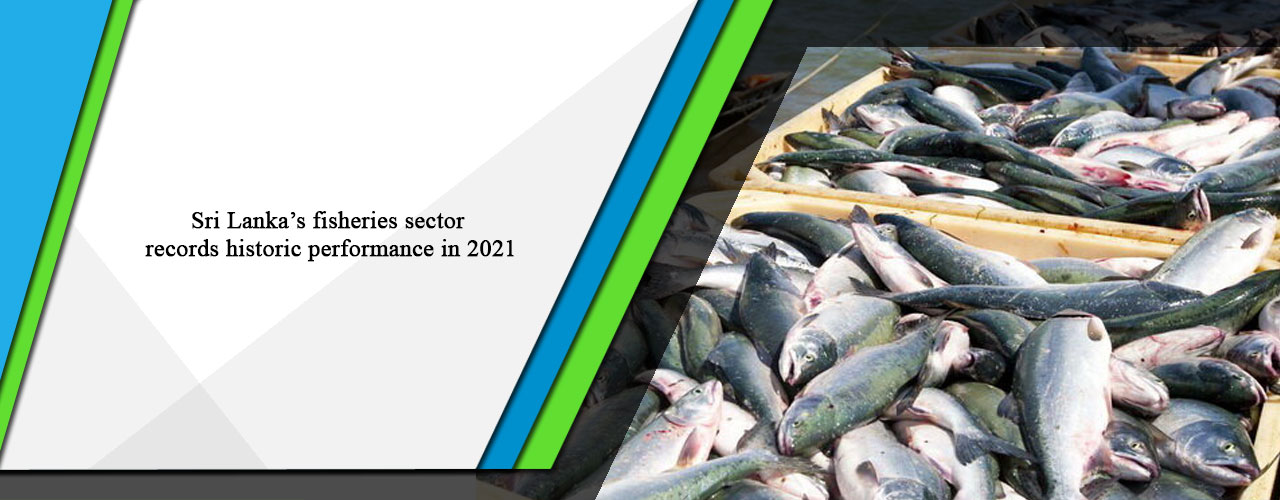Sri Lanka’s fisheries sector records historic performance in 2021
Daily FT: Amidst the numerous pandemic-induced challenges, a silver lining for Sri Lanka was the record-breaking performance delivered by the fisheries industry in the year 2021.
Exports exceeded forecasts to deliver many firsts: achieving the highest export value in history at $ 318 million as against $ 215 million in 2020, the largest balance of fish trade in history at $ 192 million compared to $ 23 million in 2020, lowest import value and quantity in over a decade of $ 126 million and 56,176 MT ($ 191 Million and 85,809 MT in 2020), the highest production of shrimp farming in history, which almost doubled from the previous 14,415 MT; an increase of 162% in shrimp export value, an increase of 74% in exports value of ornamental fishery to $ 21 million; and more than doubled domestic canned fish production.
Domestic production increased from 90,000 cans per day in December 2020 to 220,000 cans per day in December 2021 as against the domestic requirement of 275,000 cans per day. A decrease of 76.2% in imports of canned fish was also recorded as compared to 2019.
The fish and fisheries sector plays an important role in Sri Lanka’s social and economic life. The sector contributes about 2.7% to the country’s GDP. The lifting of the ban on Sri Lankan fish exports to the European Union (EU) in 2016 and the restoration of the GSP+ concession in 2017 has given a significant boost to the fish and seafood exports industry. The sector generates close to 2.4 million direct and indirect jobs.
Commenting on the break-out performance Seafood Exporters Association of Sri Lanka President and Taprobane Seafoods Ltd., Director Dilan Fernando said : “I am so proud to state that the fisheries exports sector delivered a superlative performance despite massive challenges faced due to a COVID-19 cluster within the industry stakeholders, lockdowns, rise in freight costs, shutdown in export markets, the XPressPearl maritime disaster and floods in the Puttalam District.
“The resilience and courage of all the exporters can be witnessed in how they surmounted these odds to record such high export numbers. One of the pillars of this performance has been that all the stakeholders in the industry and the authorities had a common vision to ensure the fisheries remained unaffected to the greatest extent.”
Shrimp farming in Puttalam increased from 6,000 Mt to 14,000 Mt in 2020, which was a doubling of production, of which Vannamei accounted for 90%. In June 2021, the Government banned wild broodstock for post-larvae as disease and outbreaks were rampant.
However, SPF broodstock is now being imported and is disease-free as it is created in a disease-free environment. From here on, growing them and ensuring their health is in the hands of the farmer. The ornamental fish sector has also done well. With more people at home due to the pandemic, this industry has seen growth.
The Government is also moving more into private and public partnerships. Rekawa and Batticaloa are good examples, where the Government is calling for tenders to farm unutilised land for farming.
Over 5,000 acres in Batticaloa and Hambantota are being considered for expression of interest, which adds even more farming land to expand fisheries.
With this in mind, the Government is also offering shrimp farmers a low-interest loan to support them to scale up their businesses. They are supporting the industry to convert mud ponds to HDPE lining to increase growth cycles from two to three cycles while doubling the harvest. Farmers can opt for up to 5 M per pond and go up to 20 ponds per farmer with a payment period of two years.
OSL take:
The growth recorded by the country’s fisheries sector last year is expected to continue this week with further growth this year. Sri Lanka’s fisheries industry has received a boost from the many trade agreements as well as concessions enjoyed by the country. The government of Sri Lanka has also taken steps to uplift and develop the country’s fisheries industry as well as supplementary infrastructure facilities like fisheries harbours with the latest equipment and the upgrading of fishing vessels. The industry has also received financial assistance from foreign donors as well. Given the expanding opportunities and fund availability for development work, foreign businesses/investors could explore the business/investment opportunities in Sri Lanka’s fisheries industry.
| Article Code : | VBS/AT/19042022/Z_1 |

